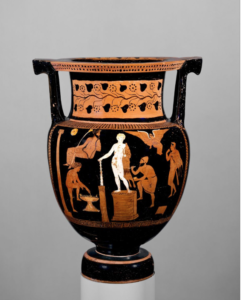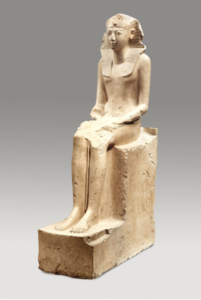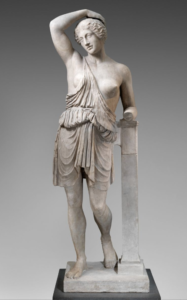Introduction: The different techniques and time periods of all forms of art have greatly impacted the presentation of the artwork. Although all three portray statues the way that these statues are articulated have created a line of differentiation amongst the two. Ancient Egyptian, Ancient Roman and Ancient Greek artwork symbolize the different roles played in society during the coinciding time periods. In museums and pictures the statues display character and a certain poise while the three illustrate different aspects of the given time frames and the different societies. Although the three forms of art hold similarities, they differ in many ways. Ancient Greek artwork is significant in articulating human like statues. They used human forms to display god like statues and display the traits of a dominating human. Ancient Roman artwork is significant for displaying different forms of art using marble, stone, glass, metal, etc. Ancient Egyptian artwork is significant in portraying the image of gods. Ancient Egyptian artwork was surrounded by religion and the afterlife. They would fill tombs of Pharaohs with scriptures and paintings for their afterlife. The sculptures created during this time period mainly displayed the image of Pharaohs who were considered gods during that time period.

Statue of Aphrodite
Artist: Unknown/ Purchase, 1952
Date: 1st or 2nd Century A.D
Museum: Metropolitan Museum
In this statue Aphrodite the Goddess of love is shown surprised while taking a bath, with her arm extending to cover her breast in a phase, which both hides and reveals her sexuality. This was not surprisingly a huge deal for the Greeks. Aphrodite is the goddess of love, desire and beauty and the daughter of Zeus. This statue of the Goddess represented a celebration of the female body in an ideal form of beauty, proportion, and grace. This was one of many different nude Greek female figures we saw at the MET but this one stood out a lot more than the rest. As a class we have discussed Aphrodite in many of the text we read throughout this semester, including the Iliad and odyssey of Homer.

Statue of Dionysos
Artist: Pacetti, Vincenzo
Date:27 B.C.–A.D. 68
Museum: Metropolitan Museum
In this figure of Dionysos he is appeared to us standing with his left arm over on an archaistic female figure identified as Spes, the personification of hope. He is shown wearing a panther skin over his chiton and a cloak wrapped around his upper right arm and shoulder. The panther skin was a great symbol to identify this God just like wine would have been. In order for a support a part of the cloak flows around the back and over the head of the God. Another Greek female figure stands in front of the God of wine with her feet together on the base, while holding the lower part of her dress to one side. After understanding the figure’s costume, hairstyle, and explicitly her pose it persuades us that it’s a representation of Spes, a Roman personification of hope. Rather than the Text the God Dionysos was essentially discussed in the lectures that took place in class.

Terracotta Column- Krater
Artist: Group of Boston
Date: 360–350 B.C.
Museum: Metropolitan Museum
This Greek vase in orange and black caught my attention right away, because we had seen similar images in the Power point discussions in class. The paintings on the Vase portray a Styr waiting for Dionysos, the God of wine with a jug and jar, where you can assume it had something to do with the Styr wanting wine while on the other side another Styr uses gestures to express abandons.

The Seated Statue of Hatshepsut
Artist: Unknown/ Rogers Fund, 1929
Date: 1479–1458 B.C.
Museum: Metropolitan Museum
This a limestone statue that honors Pharaoh Hatshepsut during her joint reign of power with Thutmose III, which was made around 1479-1458 BCE. The statue shows Hatshepsut seated, showing that she was a woman of power and authority. She is also wearing a headdress that only pharaohs and royal people wore. The statue is not naturalistic because of the awkward position that Hatshepsut is shown in, which is very common for ancient societies such as the Babylonian and the Egyptian. The pharaoh has an unnatural and stiff face and body and is not a way to depict the pharaoh. We can see that the pharaoh shows evidence of being a female because of the breasts and because of her long legs. The statue shows evidence of being damaged because the statue is not fully intact. The lower part of the right arm is missing as well as the left hand. The information also indicates that the statue was fragmented and had to be reassembled. The upper body was were excavated in fragments and the lower body was in another museum. Across the sides of the pharaoh’s seat are hieroglyphics which probably tell the story of Hatshepsut. This form of writing is used as a way to write down the story and life of the person, which is another method used by the Egyptians.

Marble Statue of a Wounded Amazon
Artist: Unknown/ Gift of John D. Rockefeller Jr., 1932
Date: 1st–2nd century A.D.
Museum: Metropolitan Museum
This is a Roman statue created in between 1-2nd century CE, and is a copy of a Greek bronze statue from 450-425 B.C. The statue shows the mythical race of Amazonian women who would battle against heroes such as Achilles. The statue shows a wounded warrior standing in a naturalistic way. The use of contrapposto is present, a Greek creation, which tries to show the shift of weight onto one foot. The body of the warrior is expressed more by showing the warrior’s body, specifically breasts. The warrior is wounded under her right breast and also there is evidence of multiple scars on the back that show that she is a warrior. The facial features are detailed and realistic, but the facial expression is not expressive which indicates the acceptance of death. The warrior’s right hand is wrapped around her head indicating that she is not in pain or struggling, which further indicates that she has accepted death. The warrior is wearing her fighting clothing which openly show her body, indicating that this was considered common in her culture.
Conclusion: Although these time periods have presented various forms of art, their artwork displays numerous similarities. They all display human like figures and are all presented in sculptures. The eyes, nose and certain physical features amongst all three: Ancient Greek, Ancient Roman and Ancient Egyptian art show distinctive traits as a human being. All three artworks display a dominant structure that essentially displays power and a higher or stronger being. The differences amongst all three artworks are clearly shown through the different sculptures. Ancient Egyptian artwork revolves around the representation of god or a high power. Which was displayed through Pharaohs. Ancient Roman artwork revolved around the illustration of sculptures that were presented in different materials such as bronze, marble, glass, metal and stone. Ancient Greek sculptures show a dominant male who has feminine characteristics and is shown having a muscular image. Ancient Greek sculptures relate to how a human being looks, they show a feminine side by allowing the sculptures to show a slight slouch or a soft knee bend, etc.
Sources:
http://history-world.org/arthist.htm
This article talks about the differences between Ancient Greek and Ancient Roman artwork. This article presents the similarities and differences amongst the two.
https://www.jstor.org/stable/985469?seq=1#page_scan_tab_contents
This article talks about the differences between Ancient Greek and Ancient Egyptian artwork. This article elaborates on different techniques used during each time period.
This article compares Ancient Roman and Ancient Egyptian artwork. It weighs in on the different music, sculptures and paintings that were idolized during that time period.
https://www.history.com/topics/ancient-history/ancient-greek-art
This article weighs in on the significant pieces of art produced during the Ancient Greek time period. This article shows images of the most popular sculptures made during the time period and elaborates on the techniques used to produce this artwork.
This article elaborates on the most popular art work produced during the Ancient Egyptian period of time. This article explains the importance of the ancient pyramids and the meaning behind the coffins.


